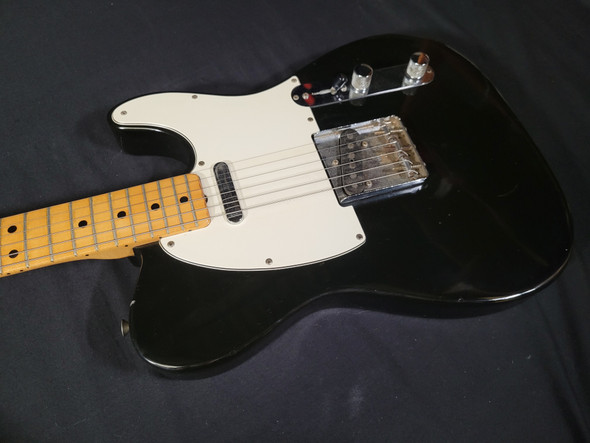1966 Fender Telecaster Black (Rare Color) (W155)
- SKU:
- 6155
- Shipping:
- Calculated at Checkout
Description
1966 Fender Telecaster in black is considered rare compared to other more common colors from that era.
-
In the mid-60s, Fender had a limited range of colors available for their instruments. The most common finishes were Sunburst, Butterscotch Blonde, and occasionally Fiesta Red or Lake Placid Blue.
-
Black was not a standard color option for Telecasters in 1966, and as a result, black Telecasters from this period are much less common.
-
During the 60s, Fender did offer custom colors (which included black) as special orders, but these were relatively rare. Guitars made in custom colors were often built on demand, making them much less widespread than the standard finishes.
-
While Fender did produce some black Telecasters in the 60s, it wasn’t until later decades (like the 1970s) that black became a more regular finish option for the Telecaster.
-
Butterscotch Blonde was the standard finish for the 1950s Telecaster, and by the mid-60s, Sunburst became the more dominant finish on Telecasters. Therefore, if a Telecaster was ordered with a black finish in 1966, it would be considered a custom order.
-
The black Telecaster would have had chrome hardware and single-ply white pickguard, which is the typical configuration for black Telecasters from this period.
-
Since black Telecasters from 1966 are rare, they often command higher prices on the vintage market. The rarity makes it highly desirable for collectors, especially if the guitar is in good condition, has its original parts, and includes vintage features such as the black guard and single-ply pickguard.
The 1966 Fender Telecaster is a classic example of Fender’s mid-60s style, marked by several key characteristics. These guitars are often highly regarded for their vintage vibe and timeless tone. Below, I’ll break down the primary features and characteristics that define this model, along with how a black finish would affect those features:
General Features of a 1966 Fender Telecaster:
-
Wood: The body is typically made of alder (in the mid-60s, Fender used both alder and ash for Telecasters). Alder gives the Tele a balanced, clear tone with a slight midrange punch, which contributes to the Tele’s signature sharp and bright sound.
-
Finish: As mentioned, Black was not a common color in 1966, so a black Telecaster would be considered custom or special order. If it’s a factory finish, it would likely have a glossy black finish with a single-ply white pickguard.
-
Shape: Standard Telecaster shape, with a single-cutaway body that’s comfortable for both rhythm and lead playing.
-
Material: The neck is typically maple and is a bolt-on design. The Telecaster neck is one of the most recognizable features of the guitar, and in 1966, it was still made with the traditional maple “skunk stripe” running down the back of the neck.
-
Profile: The neck is usually a “C-shape” profile, which is still a bit chunky compared to today’s more modern necks, but it is comfortable and great for chord work and lead playing. By 1966, Fender had started moving away from the earlier V-shaped necks of the 50s, and the C-shape was more common.
-
Scale Length: The standard 25.5” scale length was still used, which contributes to the guitar's bright and snappy attack.
-
Material: In 1966, Telecasters typically came with a maple fretboard (most common for 50s and early 60s models). In later years, Fender introduced rosewood fretboards, but maple was still the dominant choice in ‘66.
-
Fret Size: The frets were narrow and tall, typical of Fender’s designs in the mid-60s. This can give the guitar a slightly higher action and a bit more “snap” when bending strings.
-
Dot Inlays: The fretboard would have white dot inlays, which is consistent with the Telecaster's simple aesthetic.
-
Single-Coil Pickups: The '66 Telecaster would come with the classic single-coil pickups (neck and bridge), which is the defining feature of the Tele sound. These pickups are bright, clear, and have a distinct twang that makes the Telecaster so popular with country, rock, and blues musicians.
-
Neck Pickup: Warm and mellow compared to the bridge pickup, the neck pickup provides a smooth, rounded tone.
-
Bridge Pickup: Bright, sharp, and twangy, the bridge pickup delivers the Tele’s signature cutting tone. It’s perfect for bright, percussive strumming or biting lead lines.
-
Pickup Configuration: The 1966 Telecaster would have the classic two-pickup configuration, with a 3-way pickup selector:
-
Bridge pickup (bright, cutting tone)
-
Neck pickup (warmer, mellow tone)
-
Both pickups together (middle, spongy tone)
-
-
Volume and Tone Controls: The vintage-style 1966 Telecaster would feature one volume knob and one tone knob, with the standard "treble" bleed mod that helps preserve high frequencies even when you roll down the volume.
-
Tone Control: It offers simple, effective tone-shaping, allowing you to dial in the perfect amount of warmth or bite.
-
Bridge: The 1966 Telecaster would have a vintage-style 3-saddle bridge, often referred to as the “ashtray bridge”. This bridge is part of what gives the Telecaster its distinctive tone. The three-saddle design (one for each string) may cause intonation issues for some players, but it's a hallmark of the vintage Tele sound.
-
Pickguard: A single-ply white pickguard would typically be used on the black finish, contributing to the classic 1960s look.
-
Tuners: Fender used vintage-style tuners with chrome-plated heads that provide stable tuning, but they are not as precise as modern tuners. Over time, these tuners can show signs of wear, adding to the guitar's relic appeal.
-
Rarity: As noted, Black was a custom color during the 1960s, so a 1966 Fender Telecaster in Black would be a rare find. It's likely a special order, and not part of the standard color palette at the time.
-
Aging: If you find a 1966 Black Telecaster today, it may show signs of aging and wear, especially if it has been played extensively. The finish might be faded, cracked, or show some "checking" (cracks in the finish due to aging), which adds to its vintage charm.
-
Bright and Twangy: The Telecaster is known for its sharp, twangy sound, especially from the bridge pickup. It has a lot of snap and bite, making it ideal for country, rock, blues, and even punk music.
-
Clear and Defined: The neck pickup provides a warmer, more defined sound, ideal for rhythm playing or more soulful, bluesy leads.
-
Playability: The C-shaped neck and 25.5” scale make the Telecaster a comfortable guitar to play, with a fast action and plenty of sustain. The solid, bolt-on neck construction offers great stability and reliability.
-
60s Style: By 1966, Fender had begun to make slight changes to the Telecaster design. The neck profile was slightly thicker than the super-slim 1950s necks, and the headstock began to sport the transition logo (“Fender” in a more squared-off font with Telecaster written underneath).
-
No “Custom Shop” Label: If it's a 1966 model, there won’t be a "Custom Shop" label—this was before the Fender Custom Shop was established (in the 1980s). Instead, this Telecaster would have been built in Fender's Fullerton, California factory and may have the original Fender decal and other period-correct parts.
Summary of Key Characteristics of a 1966 Fender Telecaster in Black:
-
Body: Alder (rare custom color in black, single-ply white pickguard)
-
Neck: Maple, C-shaped profile, vintage-style truss rod, 25.5" scale
-
Pickups: Two single-coil pickups (neck and bridge) delivering sharp, bright tone with twang
-
Bridge: Vintage 3-saddle bridge, known for its sharp attack
-
Electronics: One volume knob, one tone knob, 3-way switch
-
Finish: Black (custom order, rare), may have relic wear and aging
-
Tone: Bright, twangy, clear with a punchy attack from the bridge pickup and a smooth, mellow sound from the neck pickup
-
Hardware: Vintage-style tuners, chrome-plated hardware, simple controls
A 1966 Fender Telecaster in Black is a rare, sought-after model, and if it’s original, it’s a highly valuable piece both for players and collectors. Its timeless tone and the aesthetic appeal of a vintage black Tele make it a truly unique guitar.






























